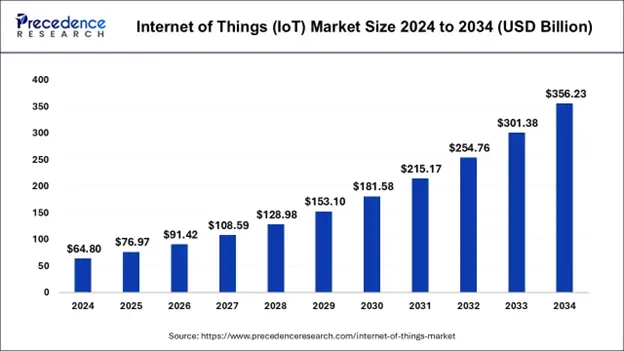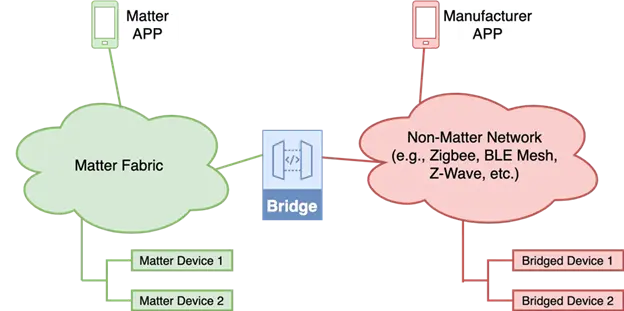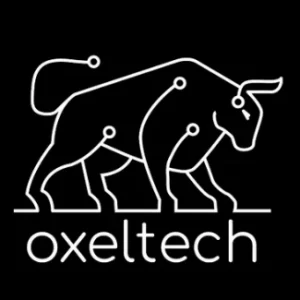Credit: CSA Matter Brand Kit
Table of Content
ToggleIntroduction
The Internet of Things (IoT) is transforming how we use and control various devices in everyday life. IoT is expanding into nearly every sector from smart homes and connected cars to industrial automation, healthcare, and smart cities. More companies are entering the market with their own devices and platforms.

Credit: Precedence Research
Consumers demand interoperability i.e. the devices from different manufacturers can work together seamlessly. This gives the consumer freedom to choose the apps and devices they like, without getting locked into a single ecosystem.
Security is also a major consumer concern. IoT networks must be highly secure so that only the authorized user can add, access and control the devices.
Matter is a unified connectivity standard designed to address these concerns. It offers a framework for device interoperability and strong security to help build a more connected, secure, and user-friendly IoT ecosystem.

Credit: Matter Logo – CSA Matter Brand Kit
What Is Matter?
Matter is an open-source connectivity standard developed by the Connectivity Standards Alliance (CSA). It aims to provide a common communication language for smart home and IoT devices, regardless of brand or ecosystem.
Matter is backed by industry leaders including Apple, Google, Amazon, and Samsung. They are taking the lead in integrating Matter into their platforms (HomeKit, Google Home, Alexa, and SmartThings).
Matter can run on IPv6-enabled networks like Ethernet, Wi-Fi, and Thread. This provides flexibility for devices to communicate directly and securely with each other and the cloud.

Credit: Qorvo US, Inc – Matter Layered Architecture:
Key Features of Matter
-
- Interoperability: Devices from different manufacturers can work together seamlessly, reducing vendor lock-in.
- Security: Matter is designed with security features including end-to-end encryption, secure onboarding, and device authentication.
- Local Control: Matter supports local control, meaning the devices can directly communicate even if the internet goes down. This also improves response times, reliability and privacy.
- Simplicity: Matter devices support QR code or NFC-based pairing, making installation easy.
- Scalability: Matter is built to grow with the IoT ecosystem, supporting both consumer and industrial use cases.
- Multi-Admin Support: You can control the same device using multiple ecosystems (e.g., Apple Home, Google Home, and Alexa) simultaneously without conflicts.
Why is Matter Important for IoT?
1. Eliminates Fragmentation
Before Matter, smart home platforms often used proprietary protocols, and each had its own set of supported devices. Matter standardizes communication across ecosystems, making devices compatible and user experience better.
2. Future-Proof
Matter is backed by major industry players. Consumers don’t need to worry about buying a device that becomes obsolete due to changing standards.
3. Boosts Consumer Confidence
With security and interoperability built-in, users can trust that their smart home devices will work reliably and safely.
4. Simplifies Development
Matter offers a standardized framework that allows manufacturers to focus on improving device functionality rather than worrying about compatibility issues.
5. Strengthens IoT Security
Matter addresses security concerns in IoT by incorporating:
-
-
- End-to-end encryption to protect communication between devices.
- Cryptographic onboarding to ensure only verified devices can join the network.
- Regular software updates to patch vulnerabilities proactively.
-
6. Enabling Local Control
Matter emphasizes local control, which is crucial for real-time responsiveness and resilience. Devices can communicate even if the internet goes down.
Connecting Legacy Devices to Matter
Matter itself is not backward compatible with older protocols like Zigbee, Wi-Fi, Bluetooth, or Z-Wave. However, it is possible for legacy devices to work within the Matter ecosystem:

Credit: Espressif Blog
1. Matter Bridges
Many existing smart hubs can be updated to act as Matter bridges, allowing legacy devices to connect to Matter networks. These bridges can communicate with legacy devices and expose them as Matter-compliant devices.
2. Firmware Updates
Some manufacturers are releasing over-the-air firmware updates for devices based on Wi-Fi or Thread, to make them Matter-compliant. However, this depends on the device’s hardware capabilities and vendor support.
3. Dual-Protocol Controllers
New generation smart hubs often support managing both legacy and Matter-native devices. This helps bridge the transition period and protects existing investments in older devices.
Conclusion
Matter is redefining the IoT landscape in the modern world. It brings universal compatibility, strong security, and seamless user experiences to matter enabled devices.
Legacy devices can still connect through bridges or firmware updates. But the most reliable experience comes from devices supporting Matter natively. Matter certified devices carry the Matter logo. When you invest in smart devices, look for the Matter logo to ensure your device is compatible and ready for the future.


